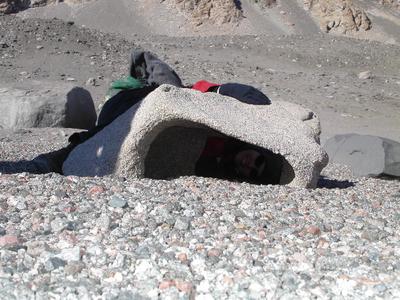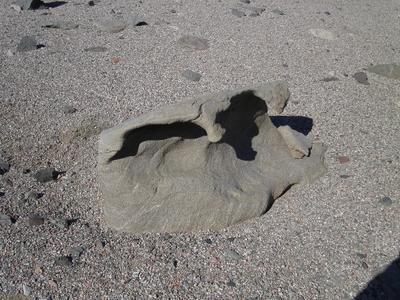
|
|
26 January, 2003
Rock-hard… Not Always!
Ventifacts are rocks shaped and polished by wind action. The term ventifacts is actually derived from the latin term “ventus” meaning wind. We have found ventifacts scattered throughout Taylor Valley, but they seem most spectacular here around Lake Joyce and into Pearse Valley.
Ventifacts can be found in all different sizes from a mere pebble to a huge boulder the size of a Volkswagon. These rocks have been sandblasted by wind-borne sand in the valleys. The ventifacts here generally seem to have three scoured facets or ridges giving them a somewhat pyramidal shape. (Look carefully at the photos below.) Some of the sandstones are affected differently by the winds and sand causing the appearance of gentle curves, hollow bottoms, pits, and even holes carved right through them.
Ventifacts can be found here in the Dry Valleys, in the desert regions of the American Southwest, and they have even been seen on the surface of Mars. Although it is not completely understood how ventifacts form with multiple facets (ridges), it is believed that perhaps they form when prevailing winds change direction during the summer and winter months. Another theory is that the rock moves when wind eddies on the leeward side cause erosion of fine sediment allowing for rotation of the rock exposing a different side to the prevailing wind. Either way, the processes that interact to form ventifacts are complex. Ventifacts form in environments that have low precipitation, little or no vegetation, strong winds that blow in the same direction for a very long time, and large amounts of abrasive parcticles such as sand, silt, and/or ice.
As we walked throughout Pearse Valley, one rock seemed to be more interesting than the next. Rocks as tiny as a dime with a pyramid shape to boulders with large eroded sides causing giant concave indents you could crawl into. Sometimes, I would pick up a rock to find that its underside had been hollowed out leaving only an outer shell. The forms and lines created by the endless array of shapes, provided thousands of intriguing visual snapshots as we strolled through the valley. I think we all tried to go about our day, sticking to the task at hand, but could not help being continually distracted by the abundance of sculptured rocks and the artistry of nature.

The giant rock hook.

Study this photo carefully to find many pyramid shaped ventifacts.

Amber peeks through a hole in this rock.

The "Ocean Wave".
Contact the TEA in the field at
.
If you cannot connect through your browser, copy the
TEA's e-mail address in the "To:" line of
your favorite e-mail package.
|
